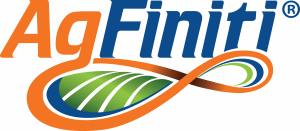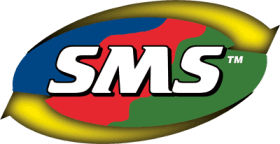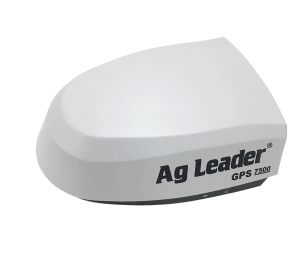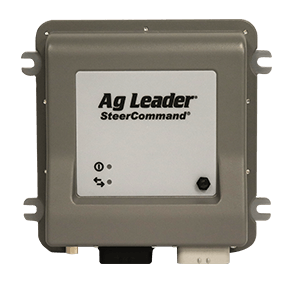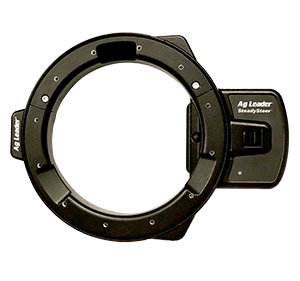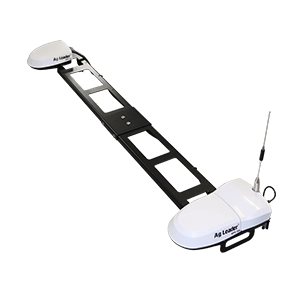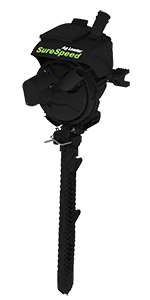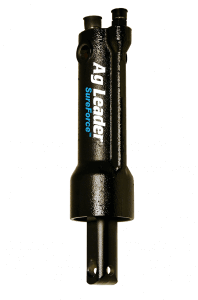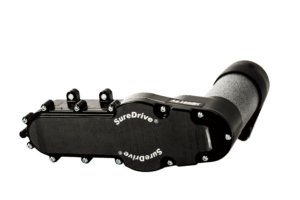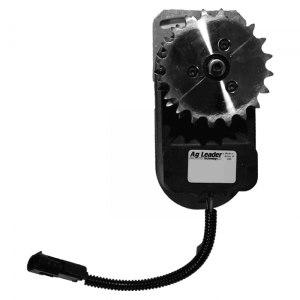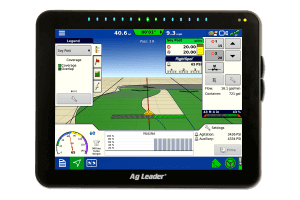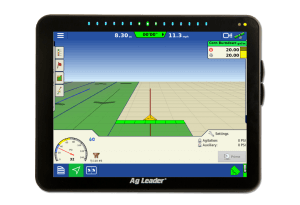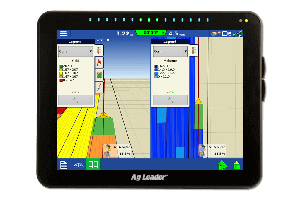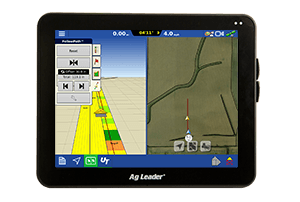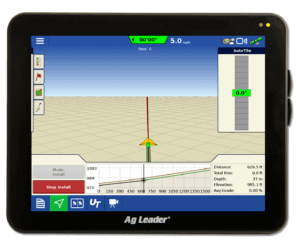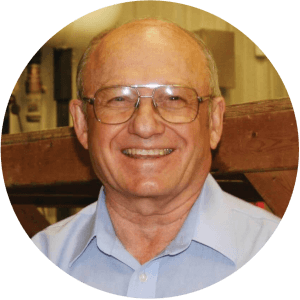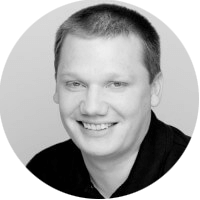30 Years of Innovation and Evolution - Ep. 1
From the first on-the-go yield monitor, to the full line of ag precision products today, founder Al Myers has definitely created a legacy for himself. But what does the future of that legacy look like? Hear from both Al and his son, Mike Myers, to find out where the future of Ag Leader is headed.
Al, Mike and Russ Background
Russ Morman 0:52: Now, sitting before me is Al, Founder of Ag Leader and his son, Mike, who’s the Vice President of Finance and Engineering.
We’re going to discuss everything there is know about the evolution of Ag Leader. So, first off Al and Mike, thank you for joining me today on the inaugural podcast for Ag Leader.
Al Myers: Yeah. Thanks for having us here today, Russ.
Mike Myers: Glad to be here
Russ Morman: Al, before you started Ag Leader, tell me a little bit about your background. I know you grew up on a farm in Illinois, but give us a little background on yourself.
Al Myers: Yes. I grew up on a farm in eastern Illinois, it’s about 90 miles straight south of Chicago, Illinois. It was a diversified crop and livestock farm. So did a lot of things, but I loved to work with the machinery and the field machinery. I know when I was in high school, I took vocational ag. I thought I’d end up being a farmer. Like most kids really, didn’t understand or plan out your future.
But one day my agriculture teacher, he said, you know, you ought think about engineering. I guess he could see that I like machinery and technical things and that kind of thing. So, I think it was my senior year in high school. I had an opportunity to go to Engineering Open-House at the University of Illinois, which is only about 65 miles away from where I grew up. And I was just fascinated by the things I saw in the various engineering departments there because that’s a day where they allow potential future students or anyone who wants to come in and take a look to go to the various engineering departments, where they’d put up displays about what that kind of engineering was about and so on.
So, I was fascinated by that. And so I decided to enroll in Agricultural Engineering at the University of Illinois. Certainly after the first year I realized, yeah, this is for me. I like the math and science and that kind of stuff. I wanted to be like many young people interested in engineering. I wanted to be a machinery designer, actually studied engine design quite a bit.
Russ Morman: I didn’t know that.
Al Myers 3:03: You know, I wanted to work for one of the big companies like Caterpillar, John Deere, you know, had big operations in Illinois. I did have summer jobs. First one was spent a summer at the International Harvester Farm Equipment Engineering Center in the Chicago area, still part of CNH today. I’ve been in the same building a few times as a representative of Ag Leader. And I worked the summer at the John Deere Harvester Works in the Engineering Department there, it would be 1970.
When I graduated in late summer of early fall of ’71. Of course, I was interviewing six months earlier. Those big companies weren’t hiring, because I guess it was a down year in the machinery business. And I ended up working for a hydraulics division of SundStrand Corporation in Rockford, Illinois. And a little less than a year later, I was transferred out here to Ames, Iowa, where I worked for about 21 years total for that company before I decided to start Ag Leader.
But it wasn’t an instantaneous decision. I started the company 30 years ago, but I actually spent six years prior to that, while I was still working full-time in the hydraulics industry. On my own, and using my father as my first field tester over in Illinois, I developed the on-the-go yield monitor in 1992 started a company and started producing and trying to sell a few of those.
So really, it was a 36 year journey from the very beginning of trying to create a product and a company to today.
Russ Morman: So, I’ve been fortunate to I’ve been a part of it for a little over 25 years now. You know, when I first started, we had the YM 2000, the GPS 2000 and Precision Map. It was three fairly simple, straightforward products. And it’s certainly evolved a whole lot from there.
Mike, a little bit about your background. I mean, you’ve been here for a long time. We were talking kind of off air here, because I wasn’t exactly sure when you started full-time and you told me you worked summers ahead of that, but prior to that, did you know you were going to come to Ag Leader?
Mike Myers 5:16: Honestly, no, I was at Iowa State for computer engineering and like, most of the people I was with, we were all thinking, oh, maybe we’ll work for Apple or Microsoft, Amazon, something like that. I was real interested in potentially maybe working for Cray Supercomputing. But, I ended up working here instead.
The way it actually happened was I was working in the engineering department full-time in the summers, while I was in college. And before my senior year at Iowa State, Al came to me and asked, hey, would you mind taking a semester off from school or something else? And I didn’t really like that idea, but we were working on the Insight Display and it had to get done by the end of that winter so that we could ship it on time. And so I said, yeah, I’ll go to Iowa State part-time and work 25 to 30 hours a week here doing engineering. And when I graduated from Iowa State, it seemed obvious to me that I could bring a lot of value to the company, so I basically just stuck around after that.
Russ Morman 6:45: It’s funny, I was kind of thinking back about my journey, starting at Ag Leader and a lot like you, I didn’t know exactly what I wanted to do. I had a degree in Ag Business or I was getting a degree in Ag Business and it was my last semester at Iowa State.
I had a sales class, the only sales class I took. And there was a gentleman in there by the name of Reed Hester and I got to be good friends with him and out of my group of friends at Iowa State, I was the only guy that didn’t have a job. Apparently I interview poorly. And I was lamenting to him, I haven’t got a job yet. I’m going to graduate and I’m going to have all these college loans. He says, hey, the company I work for is hiring and I was like, okay. And so I think Reed had said something to Al way back then. And the gentleman who I took over for was leaving to go teach, Alan. And I came in and we had a three hour interview, which was the longest interview I’d had to that point. I got a tour of the facility and the most memorable thing about the interview, that I remember, is we sat in your office which was basically a couple of eight foot tables and some prefab shelves. And I was telling you about where I was from and about how my family farms and you said, hey, what was your uncle’s name? And I told you, and amazing enough, you turned around, opened up a spreadsheet on your computer, which is how we handled registrations at the time, and you go, yeah, there’s your guys’ YM 2000.
And to be honest with you, I didn’t even know we had a YM 2000. At that point, I just needed a job and 5 or 10 years after that, it was either my 5 or my 10 year anniversary. You told a story that I didn’t know. And when you had called to offer me the position, I was still living at home. And apparently, you almost didn’t hire me. And I don’t know if you want you to elaborate on this at all or not, but I picked up the phone and I went “Yellow” and you’re like, I don’t wanna hire this hillbilly. And so, you know, 25 years later here we are, but do you remember that at all? I mean, you kind of roasted me.
Al Myers: I don’t remember the details of the interview. I certainly remember that you replaced a guy who stayed with me only a year. He was my very first inside salesperson. I was using independent manufacturers, representatives as territory managers. Then they weren’t direct employees of Ag Leader. So, you were the second internal salesperson with the company. But yeah, I told that story and I still remember that very well. I felt like it just sounded like some redneck answered the phone. And I actually hesitated for a moment said, was I gonna offer him the job? Or was I just gonna hang up and he didn’t know who called?
How the name “Ag Leader” came to be
Russ Morman 9:35: That would’ve been the case. Yeah. And I just thought that was absolutely hilarious. Another thing that occurred to me and I might remember this wrong, when I first started at Ag Leader, we had a marketing agent, Rex.
Al Myers: Yes.
Russ Morman: If memory serves. And Rex, for those who never had a chance to meet Rex, his impression on me was if you were to take a 1950s sleuth character, that would be on a radio program, he had the leather jacket with a popped up collar and he was a really good guy.
I seem to remember that you two worked together to come up with the name Ag Leader and correct me if I’m wrong, you wanted A, first in the alphabet and it would show up first in a listing of company names.
Al Myers: Some of that is not accurate. A lot of it is not accurate.
Russ Morman: Okay. So how did you come up with the name Ag Leader?
Al Myers 10:20: The way I came up with the name, and I have never found anywhere I wrote down alternate names, I literally tried them out on my father and he liked Ag Leader the best. And I kind of thought about them a while and I said, yeah, okay, I think that’s it. It maybe a little over presumptive that you are a leader when you’re starting out as a nobody, but it’s turned out to be a great name.
Russ Morman: Yeah.
Al Myers: Now what Rex did, he was the old guy that had spent his whole career in advertising. I think he had one client that he had for close to 50 years or something like that. But anyway, I came up with the stylized logo, Ag Leader. But it was a really, really skinny and wimpy font. I didn’t have access to all these nice, fancy graphic fonts that a graphic designer would and Rex looked at that logo and he said, the name is fine, but that font is wimpy. Farmers are robust people, you need a much more robust looking font there. So the font that you see up there on the wall, the nice heavy font is one that he came up with. And he was a one man operation, but he knew what he was doing and he served us well for quite a few years, more than 10 years.
Russ Morman: All right. Yeah. I remember him being around when we first started. I don’t know where I came up with that story about alphabetical, but for some reason it just stuck with me.
Al Myers: Well, people have said to me, you choose that name because the initials of Ag Leader are AL and you’re Al. And I said, no, they had absolutely nothing to do with it. That thought never even crossed my mind.
Russ Morman: Admittedly. It had crossed mind. And then I’m like, no, there’s no way. There’s no way. That’s the case.
That would’ve been the case. I just thought that was absolutely hilarious. So that was a lot of fun, but it’s funny how you don’t always know how things are going to go. I didn’t know that I’d be here 25 years. You didn’t know, Mike, you wouldn’t be doing building supercomputers.
Creation of the YM 2000
So back up again, what was it that first made you start now developing the on-the-go yield monitor? What in your mind told you that there was a need to make the YM 2000?
Al Myers 12:36: Well, the story of why I tried to do something like that was, as I mentioned earlier, I worked for this company, Sundstrand, that made hydrostatic transmissions. One of the world’s largest manufacturers of those kind of products. The first 10 years working for that company was a lot of fun, got to design a lot of new products, which was the thing I like to do. I always like to work on something that. Or I was learning something, maybe I wasn’t the first in the world to create a product, but try to create a better version of it, that kind of thing.
And then what really changed things was the 10 year long recession of the 1980s. People old enough will remember the farm crisis where many farmers went out of business because they were over leveraged on debt and so on. Fortunately, my father, he was very conservative with his money, and he survived that okay. So, in the 1980s, the place I worked for laid off so many people, I think they went from maybe 1400 employees at the beginning of the 80s down to maybe 450 by the mid 80s. And of course all the big companies were doing the same thing, there were huge cutbacks, not only in production workforces, but in the professional staff as well, in all those machinery companies.
But anyway, you know, there just wasn’t the opportunity to design new products that were fun to work with and that kind of thing. So starting actually pretty early in the 1980s, when things started to go downhill pretty fast economically for the country and a lot of businesses not just off road machinery, automotive was in big trouble. First time that the government saved Chrysler corporation from bankruptcy. But anyway, there just weren’t the opportunities to do the things that I wanted. And I just got to thinking, well, I wonder if I could create a product and start a company someday. So, I knew I’d have to do it while continuing to work there.
Because I needed that to support my family. And so I knew I had to do something uncompetitive or something different than relating to the hydraulics business that they were in. And with an ag background, a lot of the ideas that I brainstormed were agricultural related. I can look back at some of the things I thought about that I’m glad I never got.
Russ Morman: I was just gonna ask you, what would be one or two that you’re like, oh, I’m glad I didn’t do this.
Al Myers15:11: Well, one for sure I was glad that I didn’t try to do. And one reason I would’ve avoided it is it did involve hydraulic, but if you think back about 30 years, when I started Ag Leader, that’s when these guidance hitches for three-point mounted cultivators were becoming a big thing. I know by the time I started going to farm shows those guidance hitches for rear mounted cultivators were becoming a big thing. I mean, there were six, eight or more companies manufacturing those because they weren’t proprietary technology. Apparently, nobody really had a patent that anybody could copy them and make them. And another thing that influenced my judgment is I had read a number of books on business and one of the books I think was called Competitive Strategy. And it was written basically aimed at large businesses. But one of the things that really caught my eye in reading that book, was what they call barriers to entry.
For example, a barrier to entry can be money, cash, capital. Like, I wasn’t going to decide to design a car and raise enough money to try to manufacture cars or tractors or something that’s requires major, major investment. My potential entry and a barrier to entry of others was technological and so that’s one of the reasons I intentionally chose something that I knew would be difficult to accomplish. And certainly designing an on-the-go yield monitor that worked well, worked accurately, was certainly a difficult thing to accomplish. It was more difficult than even I anticipated because it took 6 years before I felt I had an acceptable, functioning product. And there were some years in the middle there I kind of thought about giving it up. Glad I didn’t, but…
Russ Morman: I am too, I’ve appreciated the job for 25 years. So, I remember seeing a few of the early prototypes, you know, they certainly look a lot different than what the YM 2000 did when you released it. How many different variations were there?
Al Myers: Maybe five. I think there was one year I reused the same display and it wasn’t much of a display. It was more tiny little text display with a bunch of push buttons, that kind of thing. So I think there were five. The last one in 1991, looked very much like the Yield Monitor 2000 that I finalized and started producing in the middle of 1992.
Russ Morman: So, what was it that made you choose a yield monitor versus any of the other ideas that you had?
Al Myers 18:54: I brainstormed a lot of ideas, but one of the things that kept recurring in my mind is regarding the idea of trying to develop a yield monitor for farmer’s combines. The farmer’s yield is his paycheck, so he is very interested in that. You know, farmers have for many, many years kept track when they could, how much came out of different fields, how much came out of their bins when they would haul the grain to town? Some would work with seed companies to do some plots and have his seed salesman come out with his little weigh wagon and weigh the different varieties. And farmers are always comparing hybrids and so on. And I just thought, boy, if a farmer could see his yield when he is in the field, as he is on the go, or even be able to keep track of, let’s say, different field totals, different portions in the field. He could plant different hybrids and keep track of the yield of each one in a device without having to have somebody come out with a weigh wagon to do it.
The more I thought about that, the more I thought, you know, I think this is something that farmers would really want to have. If I could develop a product that really would do that accurately enough on the combine and in particular, show them the yield on the go. Which, quite frankly, it was a big shock to many farmers. When I first started selling the yield monitors, farmers were finding that they were seeing up to two to one difference in yield, in different spots of their field. It was not easily identified visually.
Yield variations were much greater than they expected them to be. And even though the yield monitor itself didn’t record on the go map data for the first two years, I believe of production, certainly farmers got a lot of use out of just watching the instantaneous yield display and keeping track of different portions of a field, different hybrids, that kind of thing.
So, it was a lot of hard work to develop the yield monitor, to work accurately enough to be useful. That was the hard part. But certainly even without having the mapping, initially farmers got a lot of value from watching the instantaneous display and being able to keep track of yields and by load and that kind of thing. And there were even some of the early customers, it was accurate enough that they used it to keep track of shares within a family. Where they had a large grain bin site and they put all their grain bin in the same bins. Otherwise they would have to run wagons across the elevator in town to keep track of the different owner’s shares. And in that one particular case, there was a son, a son-in-law and the father that had their own fields. And kind of needed to reasonably accurately keep track of how much of the grain bins came from the different person’s fields.
Russ Morman: I can even remember folks telling me that they bought an early yield monitor, regardless of whether they even had GPS. It was worth it to them just to be able to open up a field and know what the moisture was. You know? Oh, well, no, this isn’t quite ready. We need to go down the road.
Hopefully I’m remembering this right. But, I seem to remember you telling me at one point in time that the first several production Yield Monitor 2000’s did not have a GPS port because you didn’t know if GPS mapping on yield monitors was going to be something that would take off the way that it did. Am I remembering that right?
Al Myers 21:31: Well, I’d say what, you’re probably remembering is when I started in earnest to try to develop an on the go yield monitor, which was in 1986, I actually did not know of the existence of GPS. I did anticipate making yield maps, but I figured it would have to be done with what they call dead reckoning. In other words, a compass some type of electronic compass. So you know which direction you’re going. You obviously have to establish a start point. So you know where you started. But keeping track of what direction you’re going and how far you go, that kind of thing. It wouldn’t have produced really great maps, but it would’ve been the only thing I knew about at that point in time. It was probably three years later before I realized the existence of the GPS system.
You know, now we know that that was started by the military back in the 1970s, I believe. And there were people who knew about it much earlier than I did. I recall that I had a boss at Sunstrand once who had come out of their aviation division, because that corporation was primarily an aerospace company out of Rockford, Illinois, but they had a number of other industrial divisions. Like the one that I worked in but at one point we had some discussion about how cruise missiles know where they’re going. Those are the missiles that fly so low that they’re under the radar. And he said, well, they follow a map. And I said, well, how do they know where they’re at? The answer was obviously GPS, but what he said to me is, well, if I told you I’d have to shoot you. Because he apparently knew about it because he probably had some level of top secret clearance from the military business that they did in Rockford, Illinois. But I had, at that time, this was probably about 1981 or two, I had no idea what he was talking about, how a missile could know where it was at.
So, but certainly GPS was you know, it was still pretty sketchy when I started Ag Leader. It was starting to be written about in farm magazines before I started the company, but, you know, a year or two earlier, it was so sketchy. With the minimum number satellites operating that you couldn’t even get the position fixed all day long. You could maybe get a part of a day, type of a thing and it really wasn’t until a few years after I started the company that GPS became solid. And then when president Clinton removed the selective availability, which was the error signal that was intentionally put on the civilian GPS so that it couldn’t be accurate for military use. That’s when that’s when GPS started to become really, really usable. And then of course there were the coast guard beacons had been created for the navigation along rivers and along the coast of the country that was the first easily available, widely available differential correction that made a big improvement at that point in time.
Russ Morman: You bet. And 30 years later here we are. I think a pretty valid argument could be made that your decision to come into the industry with that Yield Monitor 2000 definitely shaped a lot of precision ag and where it’s been going.
Mike, coming into this, did you realize right away what a big contribution that Ag Leader and your father’s ideas had made to the industry and what were your thoughts coming into this as somebody who didn’t necessarily think that this was gonna be his first career choice? Looking at it now, what were your thoughts?
Mike’s Career at Ag Leader
Mike Myers 25:16: Yeah, when I first started working summers, I didn’t really realize what a big accomplishment it was. Over time, as we’ve introduced new products and I’ve learned more about the history, it became a lot more clear that in some ways you can credit him with starting precision agriculture. Before there was a display that could record the GPS and other data, you really couldn’t apply the scientific method to agriculture to improve your yields.
And obviously from that point, we’ve got many more, new technology to analyze and give recommendations and that also really sunk home when the Smithsonian had a display of precision agriculture.
Russ Morman: I had forgotten about that.
Mike Myers: There’s a YM 2000 in there and a nice little description. And to get something into the Smithsonian, it has to be something really genius or brand new or technologically advanced. And, and significant to society.
Russ Morman: Yeah. I had totally forgotten about that. Another thing that you, that you did that I thought was really interesting is trying to get in and learn about all the different parts of the company you actually worked in my department for a while. What were some things that you learned as you kind of tried, for lack of a better term, to cross train in your company?
Mike Myers 26:55: Well, I was working on an MBA from University of Wisconsin and I had not yet finished getting my MBA when I moved into Sales and Marketing, so it was a very interesting experience to see how a lot of those concepts are applied in the real world. And get exposed to things that I generally would not be comfortable with. Going to the farm shows or talking to customers, talking to dealers gave me different perspective than I had sitting in engineering, hearing here’s a need that our customers have. Can you write software that does this?
So it was very educational. After Sales and Marketing, I moved down to Operations, did some analysis there on various things that we were doing, offered suggestions for improvement. But once again, I didn’t think I’d be applying any of the supply chain management or purchasing type stuff. And then when I got down there, I had just all sorts of questions of how do we do this? What are we doing there? And it really gave me a much better appreciation of the complexity. Of all the different departments, how they have to work together and the very different roles that they play.
Russ Morman: Oh yeah. It’s kind of always been something like for the Sales and Marketing department, you guys get to design all the fun stuff and then the necessary evil is the Sales and Marketing department to go out and get it in front of people. And I can’t imagine all the different switches that get pulled from purchasing to engineering, to sales and all the different things that go to make it so that somebody can have a report card at the end of the year, that’s their yield map.
And of course with all the supply chain issues we’ve had over the past couple of years, that’s certainly been a big part of it. We went through a pandemic that changed a lot of the stuff here at Ag Leader and worldwide. And we’re still working through supply chain stuff. And I think that, as a company, we’ve done as well or better than a lot of our other peers in the precision ag industry. And I think that’s definitely something to be proud of. There’s a lot of things like that when we get to talking about, hey, what differentiates this company? And I think a lot of it is passion. I think another part of it is the displays they’re straightforward and easy to use. Well, it’s because there’s a lot of people that design these things that use them. I mean you know, not only in the sales and marketing department, but all the way down to every department at the company. There are people that use it.
So Mike, I’m sure you’ve got some interesting stories about your first coming on to Ag Leader. I mean, you’ve been here quite a few years. Would you elaborate on that just a little bit?
Mike growing up with Ag Leader
Mike Myers 29:50: Well, my first work for Ag Leader was actually when I was about 11 or 12 years old and there was no separate office for Ag Leader. It was just in Al’s office, in the room next to it, where we had all the stuff to build things.
Russ Morman: What year was that?
Mike Myers: It had to have been ’92 or ’93. Because we didn’t have a building yet.
Al Myers: 1993 is when I moved into the rented space. Is that where you mean?
Mike Myers: No, I was doing things out of home.
Al Myers: Oh, okay. That was 1992.
Mike Myers: Yeah. So I was cutting wires to length and at some point he actually had me assembling or populating the circuit boards for the YM 2000s. So I’d have to be like, okay, look on the schematics. There’s a resistor. Which one is it? Grab it, you know, put it onto the board, get it ready to be soldered on. And then I really did just odd jobs whenever help was needed.
I remember one time, I don’t know how old I was, but there was a YM 2000 update and the whole family just came into the office and we were packaging up all the double E PROMs.
Russ Morman: Oh yeah.
Mike Myers: Labeling them, putting into envelopes and we were there probably until 10:30 and I think it was maybe two or three days that we did that just to get the update out to the customers
Russ Morman: I had forgotten about the E PROM changes and all of that stuff. I actually have a couple of those yet in my desk here at the office. That’s pretty neat. Because when I started, we were in the building before we moved to where we’re at now. And it was just after it had been basically doubled in size.
Al Myers 31:36: Mm-hmm . You know, speaking of the E PROMs, there’s a good case where the technology has advanced tremendously, to update the program in the Yield Monitor 2000, you had to open it up and remove the, I don’t know, what was it, 32 pin chip and from the older and put a new one in. And today you can get your display software updates over the air, through our AgFiniti cloud platform.
Russ Morman: That is a big change. I remember that. You know, you popped it open, you were very careful where you put your hands popped open. The E PROM would come up, you’d put the new one in. I remember the whole great big tubes of those things, I’d take them to trade shows and we’d ask people to send them back. And I don’t know, however many we ever actually would get back. But I had forgotten about that.
So Mike, you’ve gotta have more stories like that.
Mike Myers: Maybe nothing that exciting, but when we first had the elevator mount unit, it was all hands on deck for that too. Pretty much everything shut down, I came in just building as many of those as we possibly could when that was released.
Russ Morman: Yeah, when the pandemic was, nobody knew what was going, everybody was really worried. You know, we were taking turns as teams coming in and building stuff in the mornings. I remember seeing you in there. Everything from my boss, heat shrinking cables to populating connectors, it was all hands on deck to make sure that we could keep going. Even though, we really had no idea what was going on with this stuff in 2020 and that was another thing that made me, really proud to work for this. Because it would’ve been easy to go, nah, not doing this we’re just going to quit. And we’ll see you in a year, but nobody did. Everybody, regardless of what department they were in, whether it was you Mike or me and marketing, every part of Ag Leader were there pitching in to make sure that we could get product out the door because people still got to eat, you got to get a crop in the ground. And for us to be able to be that supplier and be trusted with that, that says a lot.
Ag Leader's Future
So, as you think about it and moving forward you know, where do you, Mike, see things in the next five, 10 years, or even further out? I mean, I realize things can change and I won’t hold you to it, but what do you see.
Mike Myers 33:47: About four years ago, we started an innovation team within the company. Because we know that innovation is one of the core things that we need to do to sustain the company. And I was starting that team and our goal was to really help people think in different ways to come up with ideas. And sometimes when there was an idea you look at and you say, I just don’t even know if that’s possible.
The goal of that innovation team is to as quickly as possible, analyze it, try some things, see if it’s even feasible and then pass it off to development. So we are going to be continuing with that. There have been some features that have come out of the innovation team and been implemented, but we have a lot of stuff that we are very hopeful about being able to make it into a product. And if we continue that with our focus on innovation, we will have products that are new technology to the world or doing things in a different way that makes it better for farmers to get their jobs done.
Russ Morman: When I’ll interact with, with folks at trade shows or grower meetings that have been longtime Ag Leader people, they always wanna know what’s next? And, you know, it’s nice to know that we are always developing new stuff. I mean, the only constant in this industry is change. We’re in a very fast paced industry And so I think that Ag Leader does a very good job of not trying to intentionally make stuff to where, okay, this is out of date and it isn’t something we can use anymore. So, I’m sure that when you guys are working on innovating stuff, there’s a whole bunch of things that go into play like that. So I know that that’s a big part of it.
Life Outside of Ag Leader
Russ Morman 35:52: So let me switch gears for just a minute. And I want to see if I remember this right. So we’ve talked a lot about obviously Ag Leader. When you and I talk, if I were to go through a bunch of my emails, there wouldn’t be a whole lot of Ag Leader stuff. It would be, hey, did you see this car for sale on eBay or did you that’s so I know that’s one of your passions and mine as well. I know that you really enjoy this is gonna maybe fascinate some people. We’re in the industry of cutting edge technology and you like old cars and restoring old farm machinery.
Mike, I have to admit, I’m not as familiar with what you do when you’re not here, what kind of things do you like to do on the off time?
Mike Myers: Well with my family, I have two kids and they really love Legos. So, I actually am a coach for their Lego team in the Lego League.
Russ Morman: Really?
Mike Myers 36:41: Yes. And I buy a lot of the really big sets that are still challenging to them to put together. Most of the sets that are designated for their age are too easy. They can put them together in like a half an hour. So I have to buy the really big ones. So that’s one thing. I do a lot with my family, but in general, I am a major technology person. If there’s a new technology out there, I have to learn about it. A lot of times I need to try it. Buy it even if I don’t need it, just because I want to understand the technology and it gives me all sorts of crazy ideas about what you could do with it. So, I spend a lot of time just really keeping up with technology news and the new technologies and products and playing with those.
Russ Morman: Yeah. I wouldn’t be here if I didn’t absolutely love technology, but yet there’s this flip side of me. One of my passions is barbecuing meat and I do it old school with real wood and an offset smoker and that’s kind of as not technology as you can get, but I just, I absolutely am fascinated with tech.
And one story I was going to ask you about, when you came from Illinois to Iowa, did you not, I’m trying to remember this hopefully I don’t remember it wrong, did you not tow one classic car with another classic car? Am I remembering that? Did you not?
Al Myers 38:09: Yes, yeah, I do remember that. When I moved Iowa was single and I had 3 cars. So you could get the idea that I kind of kind of liked cars and hot rods and then was starting to get into sports car type stuff.
But yeah, I had a a 1970 Chevelle with the big 454, 450 horsepower cubic engine in it. And I pulled a sports car, a Sunbeam Tiger. Those were made British cars, but they were made with a Ford small block V8 engine and anyway it made it out here. But I remember I rented one of these things you could clamp on the rear bumper of the towing car and the front bumper of the car being towed. And I remember when I was disconnecting the tow car, I realized, holy cow, I just about lost this car. Because I think the front bumper was about to come lose off of it.
Russ Morman: That’s what reminded me of that because I remember you telling me that story. And I remember that because it was myself acquaintance of both of our, Stewart Lawrence, and I was the first time I’d been out to your house. And we were looking at your Chevelle that you had bought. And what stuck me about that is you and Stuart got to talking. You’d learn that he was a trained John Deere mechanic and of course he farms and uses Ag Leader stuff as well. But what was the funnest thing about that whole evening is, of course I’m a car guy, I love cars and we didn’t start one car that day. The only vehicle that you started that day was that John Deere was it a 60? That you had bought off a 4-H project.
Al Myers: That was a 4020.
Russ Morman 39:44: 4020, that’s right. And that’s the only thing we started and we were in your garage. And you got up on there and I’d never seen you smile bigger than doing that. And I’m like, okay, this is cool. Let’s start the car, you know, but I remember that was a lot of fun.
And I also remember, for those who are not from Iowa, maybe not into cars, there is a kind of a last hoorah of the year, the first Sunday of every October in Iowa, it’s a very big car cruise. And Al might be the only guy that’s ever drove a restored straight truck, a grain truck to this cruise. And I remember the first time I saw it was actually you and your other son, Steve and I flipped you a little bit of crap and asked you if you’d been doing any burnouts or anything with it. But that was definitely something different for somebody to take a restored grain truck and bring it. But I thought that was pretty cool.
Al Myers: Yeah, I think that’s about the only restored 1960s grain truck that’s ever showed up at that hot rod event.
Al’s Initial Goals vs Where Ag Leader is Now
Russ Morman 40:38: I would have to say that was right. So,Al, we’ve kind of hit a lot of different things here today. Tell me a little bit also, did you ever think that that Ag Leader would end up where it was at today, 30 years ago or 35 years ago? Where was your goal to go with the company?
Al Myers: Well, certainly I never anticipated that the company would be where it’s at today in terms of the size and the different things. When I started the company, I basically just wanted as a minimum to be successful because obviously that was concern in the very first couple years, particularly the first year. Here, you’ve got this unknown product that costs more money than the lot of the simple electronic add-ons for farm machinery that would’ve existed at that point in time. So, I first wanted to just be successful so I could have a company that I could make enough money that I could live off of and I didn’t really realize, yet, how far this was going go and all the different things that precision farming would expand into. But as these things started to become visible, as I said earlier, one of the reasons I decided to design a product start, my own company is I always like to venture into create new products.
Maybe even if they weren’t the very first in the world, create something better, create something that was, you know, reliable, easy to use, you know, was gonna last a long time, provide a value to the customer and it would turn out to be a good, successful commercial product. So, as you know, for example, as GPS technology advanced, as electronics technology advanced, I hired the people that were capable of technologically doing these sophisticated electronic designs that we needed to keep advancing the technology. For example, Mike mentioned that he worked on the Insight. It wasn’t the first color and maybe not the first color, touch screen display. I know there was some that were based off of PC type hardware, but it was the first totally dedicated, embedded design. And certainly the first, I think, widely successful color touchscreen display in the precision ag industry. So, as the opportunities started to become visible I would just hire the people I needed to make those things happen. And we’ve built a company that really focuses on building quality products, what you might call OEM level products. You know, I had experience qualifying products in the hydraulics field to OEMs, because essentially all of their business was supplying hydrostatic transmissions and hydraulic pumps and motors that went into OEM machinery. And so I had the background of knowing how you’ve got to do it right, you’ve got to make it safe, you’ve got to make it highly functional, efficient, it has to be durable, all those kind of things. So just kept marching forward and we still continue to do that today.
I know there’s many people, and some that have even approached me out of large companies, that say, well, an aftermarket company can’t survive forever.
Russ Morman 43:55: They’ve been saying that for as long as I’ve been here.
Al Myers: Yeah. Well, and even, probably before that, certainly things that an aftermarket company may pioneer become adopted by OEMs and become, you might say adopted by the masses. The aftermarket company just has to keep moving on to provide the leading edge products or niche products. The big companies do a lot of things good, but they can’t do everything that everybody wants, in the way that some people want it done.
Family Succession of Ag Leader
Russ Morman 44:27: So again, we talk about 30 years and we talk about the future and we talk about succession Mike, your kids do you see them working at Ag Leader?
Mike Myers: My son, I see a good possibility that that’s going to happen. He tells me all the time that he just wants to come to Ag Leader and work with me.
Russ Morman: Excellent.
Mike Myers: And I’ve asked him what he wanted to do. And all he says is he wants to be an engineer. He wants to be a mechanical engineer and so we’ll have to see if that comes to pass, but he might be good at software or other things, as well. We’ll just have to see what niche he falls into as he gets older.
Russ Morman: And how old is he?
Mike Myers: He is 10 right now.
Russ Morman: At 10 years old, I wanted to either be an archeologist or maybe farm. I was all about dinosaurs and farm equipment, which those two don’t really work together, all that well. So hopefully he comes on board.
Mike Myers: Yeah. I’d love to have him come in. Maybe one day in the summer when he doesn’t have school and sit down with some of our engineers and see what they really do.
Russ Morman: That’s cool.
Mike Myers: I’ve tried to tell him that my position now I don’t get to do a lot of engineering. It’s, you know, analyzing the business, figuring out what we need to do.
Russ Morman: To keep going so he can work there in another 20 years or 10 years.
Mike Myers 45:51: Yeah. So he doesn’t quite get that part right now. He just thinks that a boss is just like, hey, you’re hired or you’re fired. He’s got quite a bit to learn about that if he would want to be in management of the company. But, so far, for the last 3 years, every time I talk to him about it, it’s he wants to come here to Ag Leader and be an engineer.
Russ Morman: That’s cool.
Mike Myers: Yeah, my daughter, I don’t think she would come to Ag Leader. She wants to be a veterinarian. But we do know she is definitely skilled in coding things. So writing software.
Russ Morman: Really?
So if veterinarian doesn’t work out, maybe writing software is in her future. There you go. Like I said, I certainly didn’t end up where I thought was gonna end up when I was 10. So the future is, is wide open and looks pretty good to me.
Mikes Vision for the Future
Russ Morman 46:42: So, Mike, we talked kind a little bit about the innovation stuff that you’re involved in. What’s a goal of yours going forward with Ag Leader say in 20 years?
Mike Myers: Yeah. Well, the major emphasis to me is to grow the company, while still providing high quality products that improve the farmer’s lives.
Russ Morman: Yeah.
Mike Myers: And we want to do it in a sustainable way. We want the company to be able to last another 30 years. So that means making the decisions that are right to keep the company running with our products that we make.
Russ Morman: I hope that we’re able to do that. In my time of being on the road, working with other companies that have been acquired by bigger companies. I hope that we stay fiercely independent. Because there’s a whole bunch of positive things to say. One, it’s a little bit different for an electronics manufacturer to be located in not only Iowa, but here in the states. It’s something that we do.
Also, I’m very proud to work for a company that is owned by a family, that is family run and all the things we do right. There’s lots of folks that go, why doesn’t Ag Leader do this? Why doesn’t Ag Leader do that? I’m like, listen, we’ve been doing this for 30 years now. We’re doing something right. And we’ve got a plan going into the future. That makes me feel good. Not only because I really like what it is that I do, but because what Ag Leader does actually affects my family as well.
So, I’m certainly glad that it seems like everything’s in good hands and I look forward as long as Ag Leader will keep me around or until I get some more cars built and I want to go work on that.
But anyways, to kind of wrap this up, I have learned a lot here today. There are a few things that I didn’t know. And I just want to thank Al and Mike for being here with me today, and giving us some insights as to the evolution of Ag Leader, not only the past 30 years but the next 30 years so thank you for joining me here today.
Mike Myers: You’re welcome.
Al Myers: You bet.


